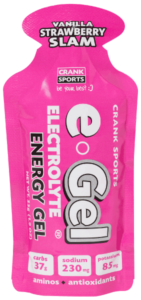What is an Energy Gel?
Energy Gels: who, when and why?
what is an energy gel?
what about water?
who should use energy gels?
everyone is different
Do you run out of energy (bonk), have stomach issues or leg cramps? Use our Sherpa Nutrition Guide tool to figure out what types of products are best for you. It’s free, quick and easy!
how do you use gels?
how much should you use?
A general rule of thumb is one every 30-60 minutes, but like most rules of thumb that’s not the best way to determine your needs and how you are going to perform at your best. For runners and cyclist we have developed nutrition analysis tools that will allow you to easily determine all of your needs (energy, hydration, electrolytes, etc.). Click below to use these free tools:
what energy gel should you use?

The problem with most gels is that they are either high in sugar (see video above), or they don’t have the electrolytes you need. Electrolytes are critical to help maintain hydration and avoid muscle cramps and injuries. Only e-Gel Electrolyte Energy Gel gives you everything you need right in the gel!
- 4 x Electrlytes to avoid cramping and injuries
- Loaded with complex carbs, just what you want!
- Low in sugar to avoid spikes and crashes
- Multi-carbs source (read why you want a little fructose)
- Thinner consistency, no more choking on thick gels!
- 150 calories per pack, fewer to carry, less trash to deal with
- no artificial colors, sweeteners or sugar substitutes
- no caffeine (read why)
- no fat, fiber or protein (video)
- aminos and antioxidants to reduce lactic acid, soreness and speed recovery
- large easy-grip top
- we beat the competition (see for yourself)
- customer proof (read below)


if you found this useful please share!
related resources
gels, drinks, chews ... what's best for your sport?
Use our Sherpa Nutrition Guide tool to get your nutrition dialed in. Just plug in your sport, problems you’re having (cramping, stomach issues, running out of energy) and Sherpa will give you a detailed person guide. Free, quick and easy!
when to use energy gels and sports drinks and can they be used together
If you decide to use e-Gel and e-Fuel together (or any energy gel and sports drink), follow these guidelines for best results.
hydration and proper use of energy gels
Before building an energy gel into your training and competition program, it is critical to understand the importance of proper hydration.
energy gels are a better choice than bars and chews
Protein bars, energy gels, chews, hydration drinks, fruit … what should you use? Making the right selection can significantly improve performance.
marathon training with e-Gel
ingredient articles
fat and protein during your race, don't do it!
In order to achieve optimum performance in any endurance sport you need to maximize oxygen delivery to the working muscles. What you eat plays a significant role.
fructose, you need some!
Fructose often gets a bad rap, but using it properly will actually give you an advantage, learn how.
hyponautremia, electrolytes may save your life
race tips and strategy
the marathon wall and how to avoid it
The bad news is that “the wall” is a very real thing. The good news is that you can avoid “hitting the wall” if you follow this advice.




